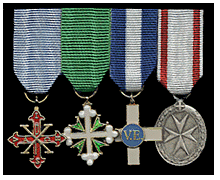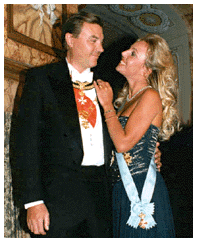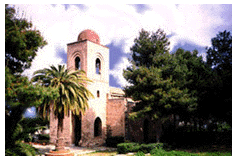...Best of Sicily
presents... Best of Sicily Magazine. ... Dedicated to Sicilian art, culture, history, people, places and all things Sicilian. |
by Vincenzo D'Urso | |||||
Magazine Best of Sicily Arts & Culture Fashion Food & Wine History & Culture About Us Travel Faqs Contact Map of Sicily |
Royal families? Italy has a few. Gone but never forgotten, the ones that survive today reigned over the Duchy of Parma, the Grand Duchy of Tuscany, and the Kingdom of the Two Sicilies (Naples and Sicily) until around 1860. Then there's the House of Savoy, which ruled all of Italy until 1946. Italy's royalty situation is not unique; Germany has a number of families that ruled over sovereign principalities before the unification of that nation. An idiosyncrasy of international law allows the heads of such dynasties, long
Without doubt, the most "Sicilian" dynasty, and the one most cherished by the Sicilian aristocracy, is the Royal House of the Two Sicilies, a branch of the House of de Bourbon which ruled from Naples from 1734 until they were ousted by pro-unification forces in 1860. The head of the family, Prince Ferdinando "di Borbone," Duke of Castro, lives in the south of France. A direct descendant of King Ferdinando II of the Two Sicilies, who died in 1859, Prince Ferdinando bestows the Order of Saint Januarius and the Constantinian Order of Saint George. The latter includes many aristocrats in Sicily, and is associated with the Basilica of the Magione, a splendid medieval church well worth a visit. The archway leading into the Magione's courtyard bears the coat of arms of the Constantinian Order. Ferdinando's son, Prince Carlo, manages the family's affairs in Italy. The Savoys, who ruled the Kingdom of Sicily for a few years early in the eighteenth century, were nearly forgotten by most Sicilians before Garibaldi's invasion in 1860, which made the Royal House of Savoy the Royal House of Italy. Prince Vittorio Emanuele, Duke of Savoy, son of King Umberto II of Italy (the last Italian monarch, who died in 1983), bestows the Order of the Annunciation, the Order of Saints Maurice and Lazarus and the Order of Merit of Savoy. Vittorio Emanuele and his son, Prince Emanuele Filiberto, live in exile outside Geneva, prevented by the 1948 Constitution from entering Italy. Born in Switzerland, Emanuele Filiberto di Savoia is the only living European who for an entire lifetime has been forbidden from entering his own country. Long before the Order of Saint Lazarus came to be associated with the Dukes of Savoy in the sixteenth century (a historically complex chain of events), it sponsored the hospital of Saint John of the Lepers,
The Order of Malta, now based in a seventeeth century palace in the via Condotti, off Rome's Piazza di Spagna, actually governed Malta until two centuries ago. Expelled from that island by Napoleon's navy, they obtained refuge in Sicily thanks to King Ferdinando I of the Two Sicilies, ancestor of the Prince Ferdinando mentioned earlier. This explains the Order's traditionally close association with the Bourbons of Naples. Treated as though they were a nation, the "knights of Malta" have sovereign territory in Italy and observer status at the United Nations, and embassies in many nations --though not in the United Kingdom or the United States. They're a Catholic order of chivalry and charitable organisation of knights from around the world. The present head of the Order, its "Grand Master," is Andrew Bertie, an Englishman. In Sicily, most knights of Malta are from noble families. Their Baroque chapel is located behind the apse of the Basilica of San Domenico in Palermo. Compared to the Order of Malta, the Order of the Holy Sepulchre seems to have less social status in Italy, even though it is bestowed on the authority of the Pope. It sponsors charitable work, and its Sicilian knights celebrate their religious ceremonies in the austere medieval Church of San Cataldo, near the Martorana Church in central Palermo. Whoever said chivalry was dead hadn't been to Sicily recently. About the Author: Palermo-born Professor Vincenzo D'Urso, who teaches in Germany, specialises in Sicilian medieval history. | ||||
Top of Page |


